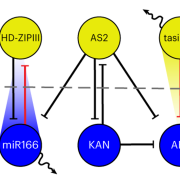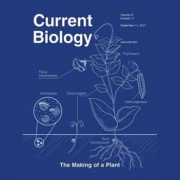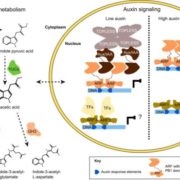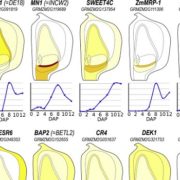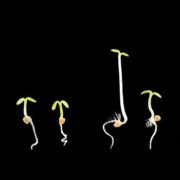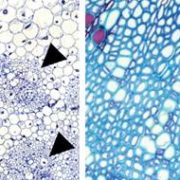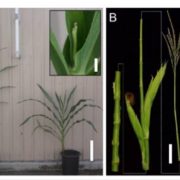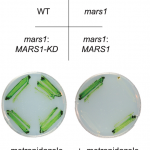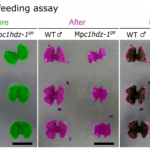A feedforward loop controls vascular regeneration and tissue repair through local auxin biosynthesis (Plant Cell)
 Plant cells are entrapped in rigid cell walls, so morphogenesis relies on asymmetric cell division (ACD) and positional cues to regulate tissue patterning. The Arabidopsis phloem is a good system to study tissue patterning due to its relatively simple composition: sieve elements (SEs) and companion cells (CCs) lineages. Although the regulatory programs that control phloem development are well known, the molecular mechanism that coordinates the ACDs that give rise to the SEs and CCs lineages is obscure. In this study, Kim et al. reveal how the SHORTROOT (SHR) mobile transcription factor orchestrates the development of SEs and CCs precursors in two different spatial contexts. By analyzing stele expression data and inducible lines the authors determined that NAC-REGULATED SEED MORPHOLOGY 1 (NARS1) and SECONDARY WALL-ASSOCIATED NAC DOMAIN PROTEIN 2 (SND2) are direct targets of SHR. Subsequent analyses showed that SHR movement into the endodermis, where it interacts with SCARECROW (SCR), indirectly activates transcription of NARS1 through microRNA165/166 to control procambial cell proliferation, and thus the ACD required for CCs. Movement of SHR into the phloem however activates transcription of NARS1 in the root differentiation zone, which, acting as a top-down mobile signal, directly activates SND2 expression in the root meristem to further amplify NARS1 expression, forming a positive feedforward loop to regulate ACD of SEs precursors. This regulatory program sheds light on the complex molecular mechanisms required for tissue patterning. (Summary by Jesus Leon) Plant Cell 10.1105/tpc.19.00455
Plant cells are entrapped in rigid cell walls, so morphogenesis relies on asymmetric cell division (ACD) and positional cues to regulate tissue patterning. The Arabidopsis phloem is a good system to study tissue patterning due to its relatively simple composition: sieve elements (SEs) and companion cells (CCs) lineages. Although the regulatory programs that control phloem development are well known, the molecular mechanism that coordinates the ACDs that give rise to the SEs and CCs lineages is obscure. In this study, Kim et al. reveal how the SHORTROOT (SHR) mobile transcription factor orchestrates the development of SEs and CCs precursors in two different spatial contexts. By analyzing stele expression data and inducible lines the authors determined that NAC-REGULATED SEED MORPHOLOGY 1 (NARS1) and SECONDARY WALL-ASSOCIATED NAC DOMAIN PROTEIN 2 (SND2) are direct targets of SHR. Subsequent analyses showed that SHR movement into the endodermis, where it interacts with SCARECROW (SCR), indirectly activates transcription of NARS1 through microRNA165/166 to control procambial cell proliferation, and thus the ACD required for CCs. Movement of SHR into the phloem however activates transcription of NARS1 in the root differentiation zone, which, acting as a top-down mobile signal, directly activates SND2 expression in the root meristem to further amplify NARS1 expression, forming a positive feedforward loop to regulate ACD of SEs precursors. This regulatory program sheds light on the complex molecular mechanisms required for tissue patterning. (Summary by Jesus Leon) Plant Cell 10.1105/tpc.19.00455
[altmetric doi=”10.1105/tpc.19.00455″ details=”right” float=”right”]


